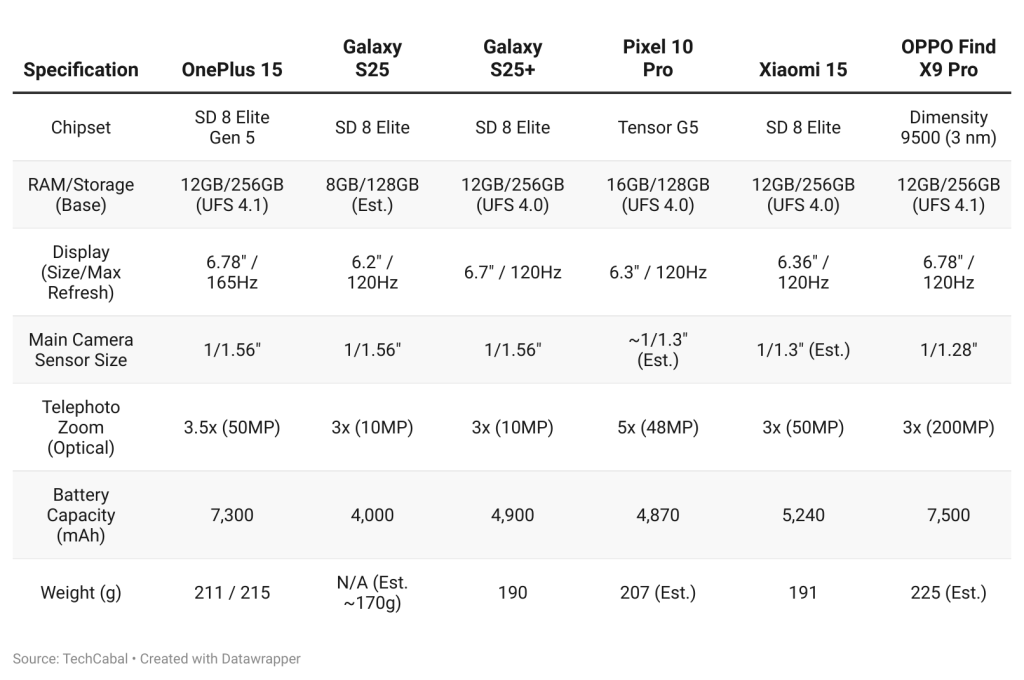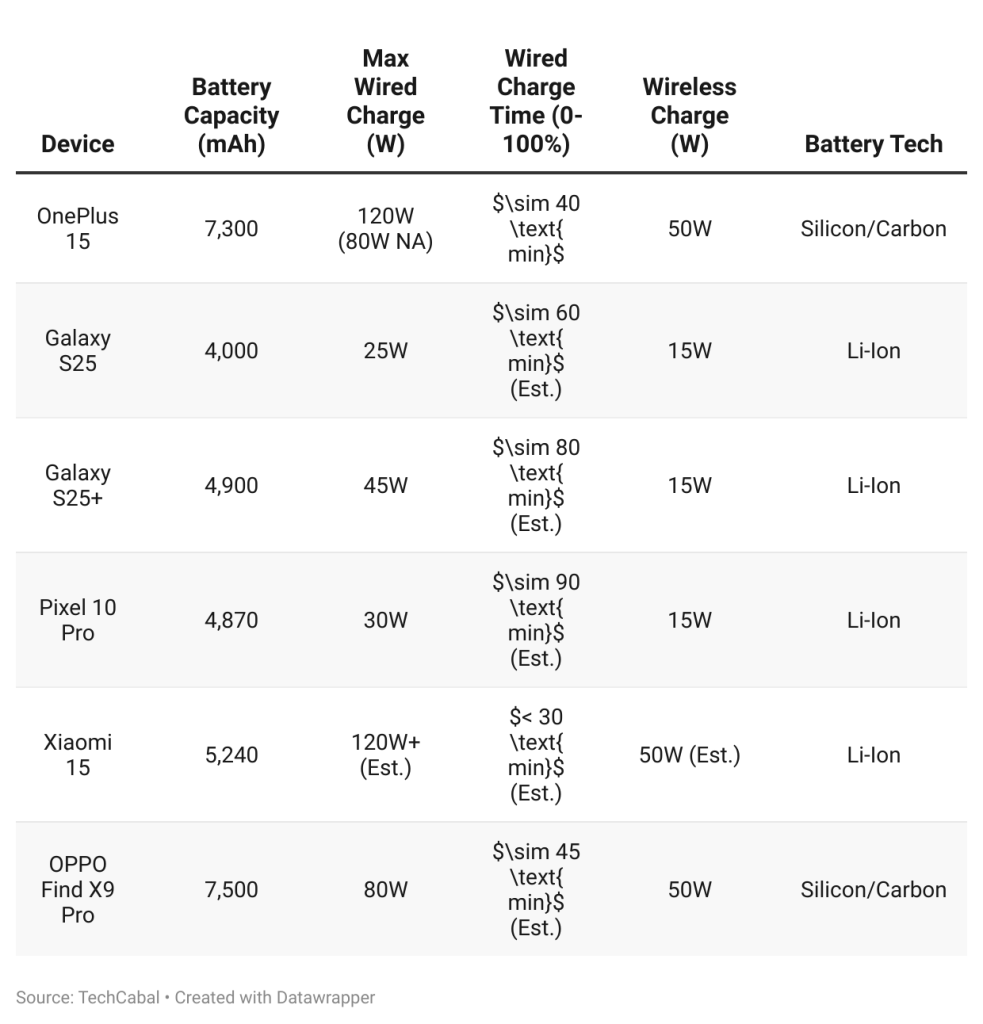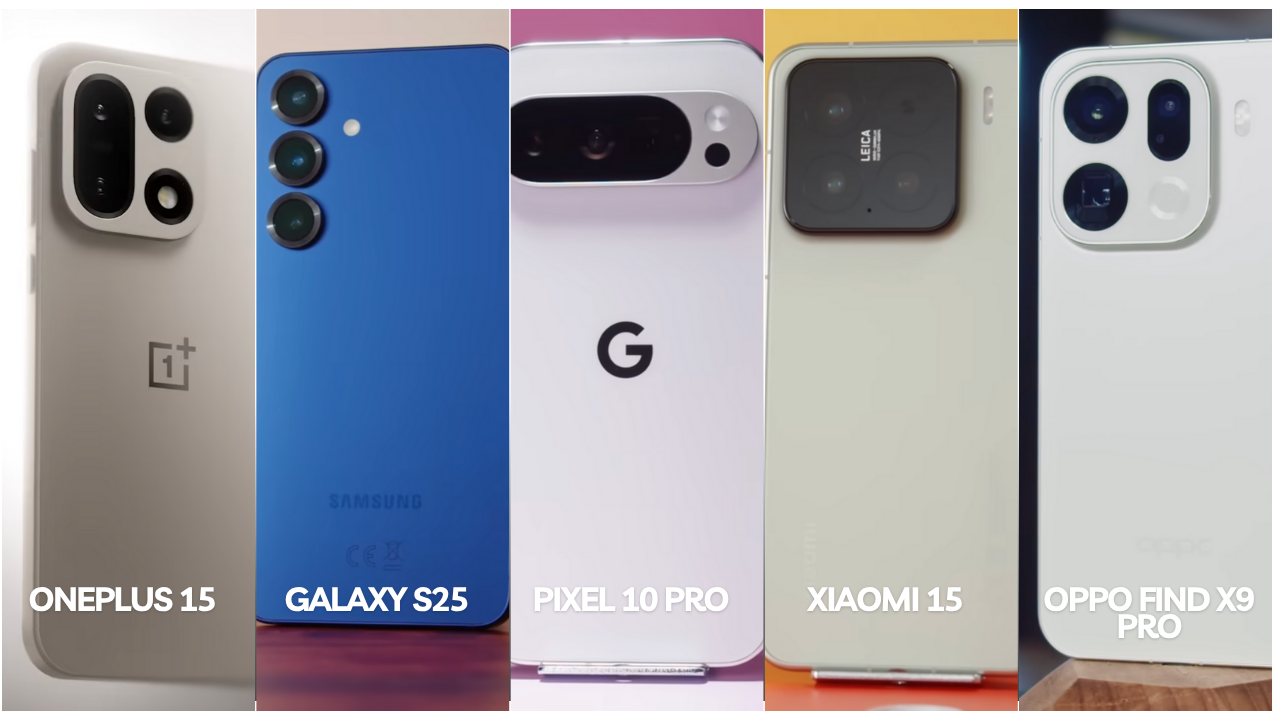The OnePlus 15 was launched globally on Thursday, November 13, priced at $899, entering a price range where every major brand wants to offer the best value. The device stands out with its strong battery and fast display, features typically found in more expensive phones.
This article compares the OnePlus 15 and other Android smartphones in the same price range, highlighting the key trade-offs in performance, software support, hardware quality, and long-term value.
How we chose the phones for this comparison
The OnePlus 15 starts at $899 for the base model. To make a fair comparison, the analysis focuses on Android flagships priced within a window of roughly $720 to $ 1,079. This keeps the comparison tight and helps you see how the OnePlus 15 fits within the upper mid-range and premium category.
Five Android flagships were selected because they are comparable in price to the OnePlus 15 and offer features that matter to buyers in this segment.
Comparative flagship matrix
What the hardware looks like on each phone
A quick look at the hardware reveals that these phones share strong processors, but noticeable differences are evident in battery choices, display priorities, and durability.
Detailed technical specifications comparison

1. Processing and display
Most competing phones use the Snapdragon 8 Elite chip, which is built for high performance. The Pixel 10 Pro utilises Google’s Tensor G5, while the OPPO Find X9 Pro employs the Dimensity 9500, offering both devices distinct approaches to speed and efficiency.
The OnePlus 15 sets itself apart with a 6.78-inch LTPO OLED screen that can reach 165 Hz. Samsung and Google typically operate at around 120 Hz. This higher refresh rate makes the OnePlus 15 more appealing if you care about smooth gaming or animations, which explains why the device requires a significantly larger 7300 mAh battery to keep the screen running comfortably.
2. Battery and charging
Battery design is where the biggest split appears. OnePlus and OPPO focus on large batteries and very fast charging. You get 7,300 mAh on the OnePlus 15 and 7,500 mAh on the OPPO Find X9 Pro, both utilising new Silicon Carbon technology to pack more power into the same space.
Samsung and Google take a more conservative route. The Galaxy S25 features a smaller 4000 mAh battery, while the S25 Plus and Pixel 10 Pro have batteries of just under 5000 mAh. Charging speeds also differ. The OnePlus 15 reaches 120 W, while Samsung and Google offer noticeably slower options.
3. Durability
All phones in this group reach the IP68 rating for dust and water protection. The OnePlus 15 and OPPO Find X9 Pro take it a step further with IP69K support. This rating protects the phone against high-pressure and high-temperature water jets, which shows extra attention to durability.
How the phones perform in daily use
Performance is more than peak benchmark numbers. You should examine how each phone performs under prolonged use, including its temperature, battery life, and image quality.
1. Benchmarking and heat control
Phones using the Snapdragon 8 Elite chip, including the OnePlus 15, Galaxy S25 Plus, and Xiaomi 15, deliver strong short burst speed. The Xiaomi 15 is smaller, so it has less room for cooling, which can make it throttle earlier during long gaming sessions or heavy tasks.
The Pixel 10 Pro takes a different approach with the Tensor G5 chip. It does not aim for the highest benchmark score. Instead, it focuses on steady performance, especially for AI tasks. During long workloads, it maintains close to the sustained performance levels of larger Snapdragon phones, which is helpful if you use your phone for extended content creation sessions or multitasking.
2. Battery life and charging

Battery life shows a clear gap. The OPPO Find X9 Pro, with a 7500 mAh battery, lasts the longest, and the OnePlus 15, with a 7300 mAh battery, is close behind. These two will give you far more screen time than Samsung and Google phones that stay under 5000 mAh.
Charging speeds follow the same pattern. The OnePlus 15 reaches up to 120 W and can refill much faster than the S25 Plus or Pixel 10 Pro. Some regions receive a reduced 80 W speed, which slows things down slightly, but it still charges more quickly than most rivals.
3. Camera performance
Camera systems follow two different paths. OPPO focuses on large sensors and robust zoom hardware, giving it a significant advantage if you prioritise high detail and long-range zoom.
Google leans heavily on computational photography. The Pixel 10 Pro may not have the biggest sensors, but its processing produces clean, balanced photos that are ready to post without adjustment.
The OnePlus 15 uses a triple 50MP setup and a new imaging engine. Early samples look solid. Your experience with this camera will depend on how well OnePlus continues to improve its software tuning over time.
What you get for your money in the long run
The long-term value of a phone depends on more than hardware. Software updates, support, and the true cost of ownership all matter when you plan to use your phone for several years.
1. Software support and longevity
Software support has become one of the strongest factors in this price range. Samsung and Google both promise seven years of major Android updates and seven years of security patches for the Galaxy S25 series and Pixel 10 Pro. This keeps your phone secure and feature-ready for a long time.
Other brands lag. The OnePlus 15 and Xiaomi 15 offer four years of major updates and six years of security patches. OPPO goes a little further with five years of OS updates. If you plan to keep your phone for more than three years, the extended support from Samsung and Google can provide you with better long-term value, even if the phone costs slightly more.
2. Customer support and accessories
Samsung has the strongest global support network, offering repair and warranty coverage in many regions. This helps you if you travel or relocate and still want easy access to official service.
OnePlus and OPPO rely more on regional support. They often offer paid protection plans but may not have the same broad service footprint worldwide. For imported models from OPPO or Xiaomi, warranty repairs outside the primary sales region can be slow or complicated.
Samsung and Google also benefit from a large ecosystem of accessories. Many third-party brands build cases, chargers, grips, and stands for them. Google also supports the Qi2 wireless standard, which keeps accessories simple and more universal. OnePlus and OPPO offer high-speed charging, but their chargers and cables tend to work best within their own ecosystems.
3. Effective pricing
Official prices for Samsung, Google, and OnePlus are typically close to the prices you will pay before tax in supported regions. Phones that rely on imports, like some Xiaomi or OPPO models, often cost more due to customs fees, exchange rates, and limited availability. This can make them more expensive in practice, even if their listed MSRP matches the competition.
Final thoughts
Your best choice depends on what you care about most, whether it is battery life, camera quality, long-term support, or a strong all-around balance.
1. Best for battery users
- OPPO Find X9 Pro: With a 7500 mAh battery and efficient hardware, the OPPO Find X9 Pro lasts longer than every phone in this group. The OnePlus 15 comes close, but OPPO still leads if you want maximum uptime.
2. Best for mobile photography
- Google Pixel 10 Pro and OPPO Find X9 Pro: The Pixel 10 Pro is great if you want clean, ready-to-share photos with little effort. The OPPO Find X9 Pro is better for users who wish to stronger zoom and larger sensors for detailed shots.
3. Best value and longevity
- Samsung Galaxy S25 Plus or the regular S25: Samsung offers seven years of software updates and security patches, which gives you the longest useful life. Although charging speeds are slower, the extended support window helps you save money over time.
4. Best all-rounder
- OnePlus 15: At $899, the OnePlus 15 offers high performance, a fast 165 Hz display, excellent battery life, and very quick charging. It is the best mix of speed, endurance, and price in this group.
5. Key Trade-offs to consider
You choose between long battery life and long software support. Phones like the OnePlus 15 and OPPO Find X9 Pro offer large batteries and fast charging, but shorter update cycles. Samsung and Google offer longer support but charge much more slowly.
You can also choose between raw power and AI-focused performance. Snapdragon phones excel at gaming and heavy tasks, while the Tensor G5 prioritises smart processing and better AI functions.
Support networks differ, too. Samsung offers wide global service coverage, while brands like OnePlus and OPPO focus more on regional support and bundled protection plans.
Smaller phones, such as the Xiaomi 15 and Galaxy S25, feel easier to hold, but their compact size usually limits battery life and cooling compared to larger models.









